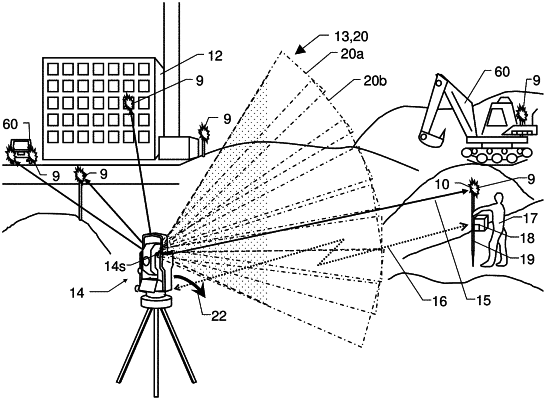| CPC G01C 15/006 (2013.01) [G01C 1/04 (2013.01); G01C 3/08 (2013.01); G01S 17/66 (2013.01); G06T 7/66 (2017.01); H01L 31/107 (2013.01)] | 14 Claims |

|
1. A target reflector search device for automatically locating at least one reflective target mark using a geodetic surveying device, the target reflector search device comprising:
a beam source, which emits optical radiation in the form of an emission fan oriented along a first direction;
a motorized drive for moving the emission fan along a second direction over a spatial region and for acquiring a value of the second direction;
a receiver, which receives reflected portions of the optical radiation of the emission fan with an optoelectronic detector as at least one reflection within a fan-shaped acquisition region, which acquisition region is moved along with the emission fan; and
a target mark locator, which determines a location of the target mark with an analysis of the receiver and the second direction,
wherein:
the optoelectronic detector is designed as a position-resolving optoelectronic detector having a linear arrangement of multiple pixels, wherein the pixels are formed as SPAD array acquisition units, which are each formed having a plurality of single photon avalanche photodiodes (SPADs), operated in the Geiger mode and interconnected to form a common output signal, per pixel, and
the receiver comprises a fixed-focus optical system,
wherein the optical system and the optoelectronic detector are arranged and configured in such a way that portions of the optical radiation reflected from a point in the acquisition region are expanded on the sensitivity surface of the optoelectronic detector in such a way that blurry imaging takes place.
|